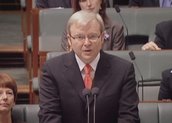


First Australians – Episode 5, Unhealthy Government Experiment (2008)
Synopsis
In this fifth episode of First Australians, European settlement spreads to Western Australia and is met with much conflict, as explored through the experiences of Aboriginal stockman Jandamarra. The history and aftermath of the Stolen Generations is examined in the stories of Chief Protector of Aborigines, AO Neville, and children such as Gladys Gilligan.
Curator’s notes
Jandamarra, an Aboriginal stockman, and Gladys Gillian, an institutionalised half-caste, are largely unknown figures in mainstream history but personify the issues at hand – the ‘killing times’ in the Kimberley, and the Stolen Generations.
Jandamarra is gifted and excels in both the white world and Bunuba lore but is soon banished from his own people for indiscretions. Like many others we see in this series, he finds himself torn between two worlds. This recurring theme doubtless reflects the feelings of duality felt by many Indigenous peoples today.
When Jandamarra eventually meets his demise, he is decapitated by the Western Australian policemen and his head sent to England in a jar – a not uncommon practice after the disposal of Indigenous freedom fighters in colonial times. It is recorded as being done after the apprehension of Pemulwuy, amongst others (see First Australians – Episode 1, They Have Come to Stay). Such a gory obsession with the body parts of Aboriginal people litters the history of British settlement in Australia (see First Australians – Episode 2, Her Will to Survive) and begs the question, just who is the savage here?
Gladys Gilligan’s experience of the 1905 Aborigines Act or ‘Half-caste Act’ contextualises and humanises what is known as the Stolen Generations. Movies such as Rabbit-Proof Fence (2002) dramatise the removal and institutionalisation of half-caste children, but knowing these are true stories increases their emotional impact.
The language used by the interviewees is not without emotional inflection but it certainly puts into perspective the reality of what occurred. Historian Professor Gordon Briscoe of the Maraduntjara Nation lists the ways in which Aboriginal people were changed as a result of the act, stating it was ‘genocide with a smile’. While the use of this term may seem harsh, these things did happen and are on the official record, and they do classify as genocide. Interview subjects describe how such things were not a secret – the legislation and its consequences were published in newspapers and it was public knowledge. Professor Anna Haebich’s concern illustrates this situation when she states, ‘Everyone knew where the Aboriginal people had gone to, it was not a secret. The big question is: did they care?’
The introduction of curfews and segregation is discussed when Gladys is sent to Perth for school. When the Chief Protector of Aborigines becomes concerned about unsanctioned fraternisation of Indigenous people and the half-caste girls ‘parading the streets’, he introduces a prohibited area in Perth, marked by streets named Boundary Streets, which still bear this name today.
We hear that approximately 50,000 children, most under five years old, were removed from their families and their culture between 1910 and 1970. It is not the sheer numbers that, to me, is so horrific but the irreparable damage done because of the separation and institutionalisation of the children. Some families have never and will never be reunited, and so many did not live to see the apology to the Stolen Generations in 2008 by Prime Minster Kevin Rudd. My own grandmother, who was taken from her family and suffered the pain of separation from her kin and culture, passed many years before the apology or official recognition that what had happened was unequivocally wrong.
This episode was first broadcast on SBS on Sunday 26 October 2008, the year of Prime Minster Kevin Rudd’s apology to the Stolen Generations in parliament.
- Overview
- Curator’s notes
- Video 3 clips
- Principal credits
- Find a copy
- Make a comment
- Map
- Add your review



